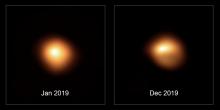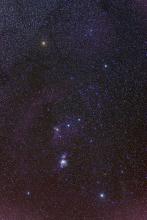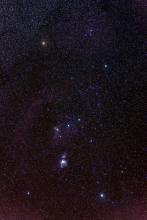Listen to today's episode of StarDate on the web the same day it airs in high-quality streaming audio without any extra ads or announcements. Choose a $8 one-month pass, or listen every day for a year for just $30.
You are here
Betelgeuse
Betelgeuse will blast itself to bits as a supernova. Many astronomers agree that that’s likely to happen within the next hundred thousand years. But estimates of the exact timing range from the full hundred thousand years to as little as a few decades.
Betelgeuse marks the shoulder of Orion the hunter. The bright orange star is in the east at nightfall, to the left of Orion’s three-star belt.
In late 2019, the supergiant star blew out a huge blob of gas. The gas cooled and condensed, forming a dark cloud that made the star fade to a third of its normal brightness. Betelgeuse rebounded, then grew almost 50 percent brighter than normal last year.
The timing of the supernova depends on what’s happening in the star’s core, which we can’t see. It may be “fusing” helium to make carbon. But it could be fusing carbon to make heavier elements. If so, then the star’s demise could come fairly soon.
A study last year suggested that Betelgeuse is late in the carbon-fusion process. After that stage, it’ll “burn” through a series of elements, ending with iron. At that point, the core will collapse, and the star’s outer layers will blast into space. The study said that, if Betelgeuse is deep into the carbon-burning process, it could explode in a few centuries — or perhaps even a few decades. For now, all we know for sure is that Betelgeuse faces a spectacular demise — sometime in the next hundred thousand years.
Script by Damond Benningfield






